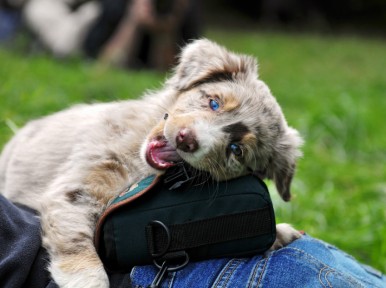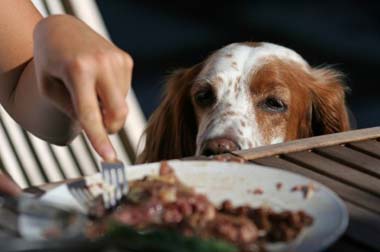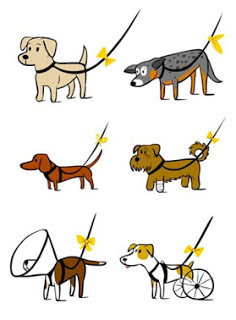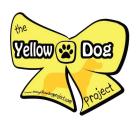 There is nothing in the world quite like a puppy – warm, fuzzy and snuggly and you’d be hard-pressed to find anything cuter! But as the holidays approach, squash those thoughts about giving the gift of a puppy. Often parents imagine the wonderment of a soft, fuzzy puppy under the tree – providing a Christmas morning that their children will never forget. Fast forward a few days, weeks or months and the reality is a puppy can put a major strain on a household. Puppies under the tree are NOT a good gift for anyone! So that begs the question: Is your household ready for a puppy? Here are 10 things you should know before adding a puppy to your household:
There is nothing in the world quite like a puppy – warm, fuzzy and snuggly and you’d be hard-pressed to find anything cuter! But as the holidays approach, squash those thoughts about giving the gift of a puppy. Often parents imagine the wonderment of a soft, fuzzy puppy under the tree – providing a Christmas morning that their children will never forget. Fast forward a few days, weeks or months and the reality is a puppy can put a major strain on a household. Puppies under the tree are NOT a good gift for anyone! So that begs the question: Is your household ready for a puppy? Here are 10 things you should know before adding a puppy to your household:
1. Puppies are LOUD! – Puppies are usually noisy creatures. Lots of barking, play-growling and even screaming. If you have close neighbours, or live in an apartment, be prepared that there may be some noise issues to deal with, particularly during early crate training and their first experiences alone.
2. Puppies make a Mess – They will have accidents in the house! It’s all part of the learning process. Be prepared to have to clean up some messes and possibly endure some carpet stains.
3. Puppies wake you up – Get on your warm housecoat and winter boots and go and trudge around in the yard at 2 am. See how it feels before committing to doing it for real, throughout the puppy’s initial few weeks. It’s very rare to have a puppy sleep through the night right away.
4. Puppies are Smart – So you’d better be too! Puppies are always wondering, exploring and learning. If you want to get on the right track, you’ll be busy managing and teaching them so that their intelligence works in your favour.
5 – OUCH! Puppies Nip – Just as babies explore their worlds by putting things into their mouths, most puppies explore theirs by biting it! This will include your hands, feet, arms, clothes and anything else that might grab their attention. Running, screaming children are an open invitation for puppy to get excited and chase with the intention of latching on… and those little needle teeth HURT! If not dealt with properly, the puppy will make this their new favourite game and it will quickly become a nightmare for the humans in the family.
6 – Puppies are Destructive – Puppies are notorious chewers. Whether they are teething or just bored, they will try to chew anything and everything. They can become destructive quickly and ruin a house. We can’t recommend crate training strongly enough. A puppy left unattended with access to the house will make short work of couches, baseboards, table legs, electrical cords…. you name it, they’ll chew it apart.
7 – Puppies Dig – Most puppies will explore their world with digging. If they are left unsupervised in the yard, be prepared to deal with holes from their exploits.
8 – Puppies are a lot of Work – To avoid all of the above points becoming an issue, one must put in the work. Puppies require time and effort. Good management, supervision and training go a long way in curbing unwanted habits, or better yet, preventing them all together. This means obedience school and hard work teaching them what you want.
9 – Puppies are Expensive – Costs for the first year of a puppy’s life will go well beyond the initial purchase price and usually include: Vet visits (inoculations, preventative medicines and special treatments such as spay/neuter), food bills, obedience school, equipment (collars, leashes, crates, beds, toys). Also, you may have to invest in groomers if you choose not to groom at home. Often dog walkers are a necessity if the pup is to be alone for extended periods while you are at work. Don’t forget to add pet sitters or boarding to your family vacation expenses if plans can’t include the puppy.
10 – Puppies Grow Up! – Our last point is our most important. That tiny, fuzzy Saint Bernard puppy is going to grow into a 150 pound adult. Are you prepared to deal with the adult version of the puppy you’ve chosen? Everyone wants a Lassie – the dog who was born knowing not to pull, not to jump on guests, not to counter surf. We all want that one-in-a-million puppy who is born knowing how to walk nicely, how to come when they are called, how to guard the house from evil-doers while giving a friendly tail wag to invited guests. If you are lucky enough to get that, you truly have won the lottery. For the rest of us, be prepared, because challenges don’t end when the pup is no longer considered a youngster. They will go from the puppy stage into adolescence where they will challenge the status quo all over again. Some pups aren’t considered adults until they are 3 – 4 years old. Are you prepared to deal with puppy antics and adolescence for that long? Good training and skills will help, but there will always be challenges to overcome.
Now, if you have made it this far, congratulations! If you can face the reality of the negatives and still consider the benefits to outweigh them, get ready for a heck of a ride and a journey that is incomparable to most. The properly raised and trained warm, sweet, loyal creature who will love you unconditionally, make you laugh on a daily basis and greet you everyday with a wiggly-bum, will add love and devotion to your life that non-dog owners could never understand. With all of these points, we would be remiss not to point out that despite all of the negatives, there is nothing in the world that is quite as wonderful as puppy breath.
 People often say that they don’t want to use “human food” to train as they don’t want their dogs to learn to beg at the dinner table. In reality, this rationalization is very far from the true reason dogs learn to beg while you eat. In actuality, you can feed your dog kibble from the table and they will learn to beg just as quickly as if they get human scraps.
People often say that they don’t want to use “human food” to train as they don’t want their dogs to learn to beg at the dinner table. In reality, this rationalization is very far from the true reason dogs learn to beg while you eat. In actuality, you can feed your dog kibble from the table and they will learn to beg just as quickly as if they get human scraps.

 Presented for your consideration: Donna & Skippy – Skippy is a happy young dog. Boisterous and energetic, always up for a good time! Innocently, Donna thinks he should socialize with all dogs – he is super friendly, after all. Skippy always loves everyone he meets and just wants to play, play, play! He walks his owner down the street and when he sees another dog, his whole body vibrates as he pulls and lunges to go for a visit. Now enter Devon and Spike – Spike is insecure. He approaches other dogs nervously: tail down, ears back, averting his gaze while trying to maintain a polite position at Devon’s side. Devon recognizes that Spike doesn’t like to greet other dogs and does her best to keep them away, but she has found that all too often, people don’t acknowledge her requests for space. As they approach each other, Devon says, “please give us space, my dog is nervous.” Donna, thinking that Skippy is just a super-friendly guy, still allows him to pull into Spike’s space. Spike reacts poorly with a growl, followed by a snarl, lunge and snap. Skippy squeals, urinates and then cowers behind his clearly agitated owner. Donna snaps at Devon, “he just wanted to say, ‘hi’. Your dog is aggressive and should be muzzled.”
Presented for your consideration: Donna & Skippy – Skippy is a happy young dog. Boisterous and energetic, always up for a good time! Innocently, Donna thinks he should socialize with all dogs – he is super friendly, after all. Skippy always loves everyone he meets and just wants to play, play, play! He walks his owner down the street and when he sees another dog, his whole body vibrates as he pulls and lunges to go for a visit. Now enter Devon and Spike – Spike is insecure. He approaches other dogs nervously: tail down, ears back, averting his gaze while trying to maintain a polite position at Devon’s side. Devon recognizes that Spike doesn’t like to greet other dogs and does her best to keep them away, but she has found that all too often, people don’t acknowledge her requests for space. As they approach each other, Devon says, “please give us space, my dog is nervous.” Donna, thinking that Skippy is just a super-friendly guy, still allows him to pull into Spike’s space. Spike reacts poorly with a growl, followed by a snarl, lunge and snap. Skippy squeals, urinates and then cowers behind his clearly agitated owner. Donna snaps at Devon, “he just wanted to say, ‘hi’. Your dog is aggressive and should be muzzled.”